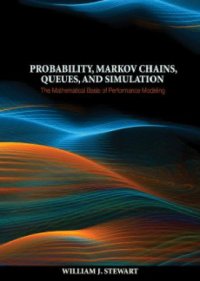
Ebook: Probability, Markov chains, queues, and simulation: the mathematical basis of performance modeling
Author: Stewart William J
- Tags: LEHRBÜCHER (DOKUMENTENTYP), MANUELS POUR L'ENSEIGNEMENT (TYPE DE DOCUMENT), MODÈLES STOCHASTIQUES + SIMULATION STOCHASTIQUE (CALCUL DES PROBABILITÉS), PROBABILITY THEORY AND STOCHASTIC PROCESSES (MATHEMATICS), QUEUEING THEORY (OPERATIONS RESEARCH), STOCHASTIC MODELS + STOCHASTIC SIMULATION (PROBABILITY THEORY), STOCHASTISCHE MODELLE + STOCHASTISCHE SIMULATION (WAHRSCHEINLICHKEITSRECHNUNG), TEXTBOOKS (DOCUMENT TYPE), THÉORIE DES FILES D'ATTENTE (RECHERCHE OPÉRATIONNELLE), THÉORIE DES PROBABILITÉS ET PROCE
- Year: 2009
- Publisher: Princeton University Press
- City: Princeton;N.J
- Language: English
- pdf
"Probability, Markov Chains, Queues, and Simulation" provides a modern and authoritative treatment of the mathematical processes that underlie performance modeling. The detailed explanations of mathematical derivations and numerous illustrative examples make this textbook readily accessible to graduate and advanced undergraduate students taking courses in which stochastic processes play a fundamental role. The textbook is relevant to a wide variety of fields, including computer science, engineering, operations research, statistics, and mathematics. The textbook looks at the fundamentals of probability theory, from the basic concepts of set-based probability, through probability distributions, to bounds, limit theorems, and the laws of large numbers. Discrete and continuous-time Markov chains are analyzed from a theoretical and computational point of view. Topics include the Chapman-Kolmogorov equations; irreducibility; the potential, fundamental, and reachability matrices; random walk problems; reversibility; renewal processes; and the numerical computation of stationary and transient distributions. The M/M/1 queue and its extensions to more general birth-death processes are analyzed in detail, as are queues with phase-type arrival and service processes. The M/G/1 and G/M/1 queues are solved using embedded Markov chains; the busy period, residual service time, and priority scheduling are treated. Open and closed queueing networks are analyzed. The final part of the book addresses the mathematical basis of simulation. Each chapter of the textbook concludes with an extensive set of exercises.
Download the book Probability, Markov chains, queues, and simulation: the mathematical basis of performance modeling for free or read online
Continue reading on any device:

Last viewed books
Related books
{related-news}
Comments (0)